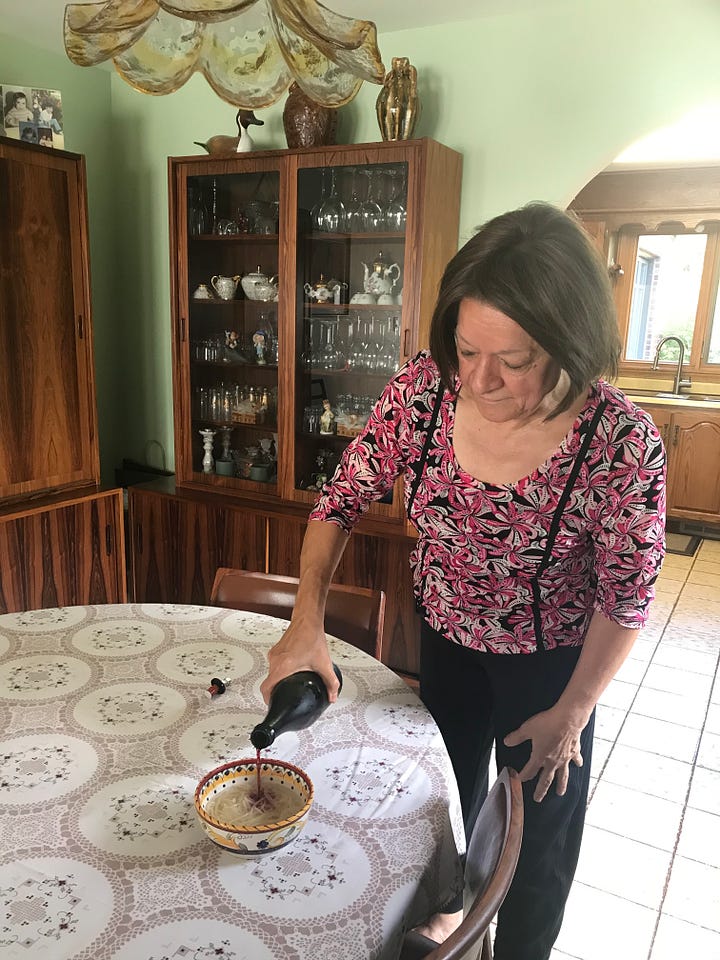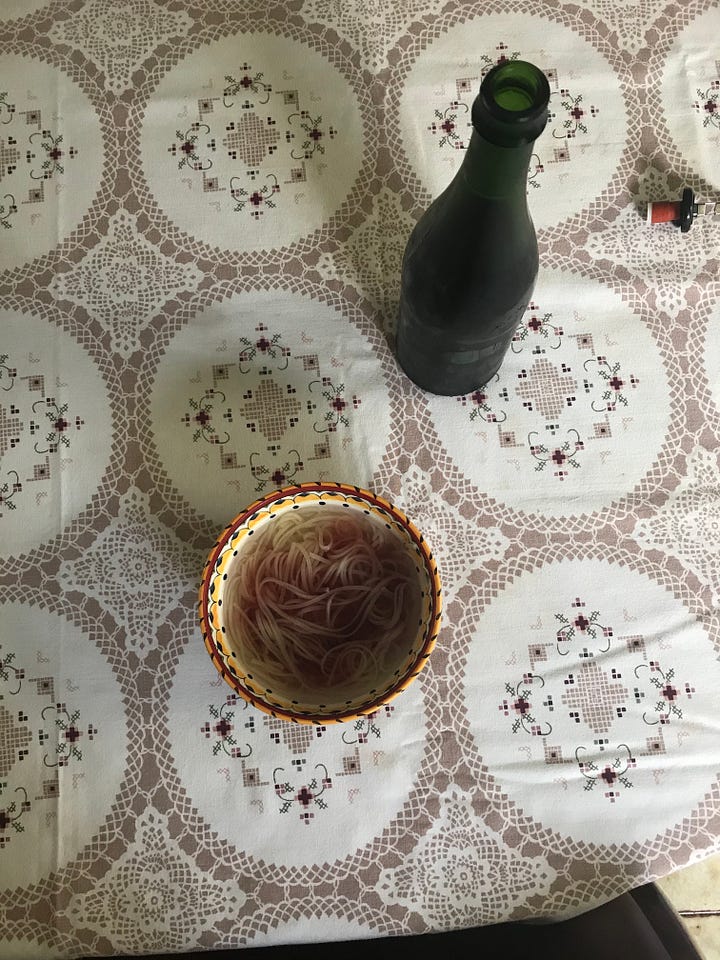We’ve officially hit real winter here in Montreal and Ottawa, the two cities between which I split my weeks. Today, we relished in the “mild” -12 Celsius, taking the opportunity to go for lunchtime walks, as we brace for temperatures in the -20s over the weekend. Perfect weather for scattone.
Last year, I wrote about egg drop soups, from homemade stracciatella to modified Lipton, because that has always been my quintessential “I’m sick and it’s cold” (or “I’m sick of the cold”) meal. Only recently did I learn about this other broth-based remedy, passed down through generations of Molisani:

I’ve noticed that it’s been making the rounds on social media,1 where it is quite polarizing. Scattone is a very simple dish consisting of pasta, acqua di cottura (“cooking water” from the pasta), and red wine, originating from Torella, Fossalto, Duronia, Frosolone, and other mountain towns in Molise. According to scattone lovers, it can cure anything. A hot bowl of scattone will warm you up, cure your colds, relieve your headaches, and aches and pains of all kinds.
It is really meant as a small dose of “medicine,” rather than a full meal. I interviewed two community members about it for the cookbook. They both described its purpose similarly: with a full day of toiling in the fields behind them, agricultural labourers would get home after the sun had set. Even in summer, nights can be quite chilly in the mountains. Usually, dinner preparations would already be underway. Scattone is served before the main pasta meal, as a way to immediately warm up the body. There are no real measurements for this dish, as it is made from a bit of the pasta that is being cooked for dinner.
As a freelance historian, I have decided to keep my newsletter subscriptions free in order to share my writing with whoever has an interest for the research and reflections in these posts.
If you’ve been following along and have enjoyed my work, liking the posts by clicking the heart at the bottom of the page is easy way to support it.

Traditionally, it’s made from homemade sagne, a typical rhombus-shaped Molisan pasta. When the pasta is ready, before straining it, pour a scoop of the pasta water and some sagne into a small bowl (not a pasta plate- small bowl!). Before serving, add a splash of wine. If you’re lucky, preferably homemade or from Molise. Some folks also add cracked pepper. That’s it. According to one of the people I interviewed about this dish, he still knows folks who enjoy a steaming hot and soothing bowl of scattone every time they make pasta for dinner.
Besides its alleged medicinal properties, scattone is considered a Molisan aperitivo because it "apr lu stommc,”2 opens the stomach. It would be followed by the rest of the pasta, maybe prepared with some beans or greens (any sauce prepared with meat would have been reserved for Sundays).


Digging around online, I found that most websites told and retold the same exact stories:
The origin myth that it was invented by accident when someone spilled red wine into a boiling pot of pasta. The name is said to come from the “scatto” they did in reaction (like snapping, freaking out, jerking quickly to catch the bottle). As it was a time of poverty, the family ate it anyway and discovered that they enjoyed it.
Or, that the name derives from the word skaitho, which they all allege means mestolo (ladle) in Molisan dialect. I have never heard this word or anything like it spoken by a Molisan in my life. I’m not sure how Alberto Zamboni, cited on the Wikipedia page for scattone, came up with this.3
That it was eaten by breastfeeding women to help them produce more milk. I have no idea where this belief comes from, as it wasn’t cited anywhere; just stated as fact. In order to avoid spreading misinformation: it is, as many now know, not recommended to consume wine when breastfeeding.
Vague, strange, and mysterious information is common when trying to trace these cucina povera recipes. Their origin stories are never fixed in any specific moment of time. It’s very “it happened to a friend of a friend of mine” vibes. This timeless quality brings both relatability and reverence: it could have happened to me and, in a way, it kind of did because I come from this peasant heritage. Those are my people and my history. And so the tradition goes on. It reminds me of the oral history research project I did on mal’occhio (evil eye). One of my main secondary sources was Sam Migliore’s Mal'uocchio: Ambiguity, Evil eye and the language of Distress. He argued that mal’occhio’s strength and persistence as a belief and tradition was its ambiguity and generality. Because it could be understood in a broad, vast sense, it was not tied to any one specific meaning or message. Therefore, its malleability allowed it to adapt through time, maintaining relevance with each passing generation.
I think the same goes for food. The stories we tell around recipes become their own sort of folklore and help shape identity and belonging, not just through flavours but through the ways of life and philosophies evoked by the ingredients and their combinations.
Researching scattone was also difficult because there isn’t anything quite like it. Usually, I can go down a little rabbit hole of related recipes that bring me to a diversity of origins, showing the movement of food, ingredients, and recipes across ancient borders. In this case, the closest I found were:
Hippocras (or spiced wine, or mulled wine)4: also polarizing. The origins here point to the quality of the wine available to folks prior to and in medieval Europe. “Wines made before the invention of modern bottling technologies were highly perishable and markedly different from the wines we drink today. […] Adding spices to these wines as they aged made them more palatable and also added health benefits from the spices themselves.”5
Spaghetti ubriachi (or spaghetti all'ubriaco, drunken pasta)6: I’ve never tried this, but I’m convinced! It sounds great. Here, the pasta is first cooked in water for a couple of minutes, then transferred over to the heated and seasoned wine to finish. I didn’t glean much more about origins here. I saw a few mentions of Tuscany.
I’m curious of other traditions where wine is used in unexpected ways. Please do share below! Now I have dreams of hosting a scattone party one of these cold winter nights…
What is drawing me to the story of scattone at this moment is its symbol as medicine. I know how healing it is to warm the body immediately upon entering your home. And to rest the body after work. Though I can’t imagine what their labour felt like, or feels like for those who are still exploited to this day. What small, strange medicines (like this hot wine soup) can we offer each other right now?
Cass
See below for monthly tarot pull and footnotes.
If you would like to support my work further, you can
(it’s like giving a tip) or share Crivello with a friend! Thank you for following, commenting, sharing your stories, and even simply continuing to open these emails week after week.
Monthly Tarot Read
Each monthly issue will include a tarot pull reflecting on the topic of the newsletter

After years of following and reading
’s newsletter, Offerings, I finally got to Tarot for Change in my TBR pile. I loved her take on the cards, which I resonated with deeply as someone who comes to tarot with a particular perspective. To reiterate (and summarize) a footnote I wrote in a previous post: for me, tarot is a creative way to approach self-reflection, and reflection more generally, connected to the work I do as a historian. Similarly to primary sources—which can’t tell us exactly, objectively what the past really was—, tarot cards don’t help me tell what the future will be. What we do, instead, is make interpretations. And those interpretations speak to something that is on my mind; or that I need to think about more; or maybe that has been buried away. Dore’s approach, combining her knowledge of tarot with that of psychology, is very much up my alley.In her description for the 5 of swords, she writes:
“All stories, for the most part, are incomplete; anytime you are a storyteller, you are also a magician in that you are drawing attention to one thing in part by diverting it from another. […] One of the jobs of the storytelling mind is to make life comprehensible, which means sorting, labelling, and categorizing. […] So much of what we see is a matter of how we frame and define it through the filter of the intellectual mind.” (311)
Often associated to failure and conflict, the 5 of swords is also usually connected to resentment and accepting defeat. Dore’s interpretation of the sword suit calls upon our “ability to generate meaning through narrative and storytelling” (309). Bringing the meaning of this card both inward and outward. What are the stories we tell ourselves? What are the stories we allow ourselves to tell, to hear? It doesn’t have to be a physical conflict.
Far right figures are telling stories about how things should be by trying to prove that they have the monopoly on truth, objectivity, and common sense. Though silly stories about the origins of dishes seem like small potatoes compared to this, the same tactic is at the core: timelessness in storytelling and mythmaking can create the illusion of an identity, a reality that “has always been.” A double-edged sword. Maybe we all learned to avoid starting our essays with “since the beginning of time” because we were told “it doesn’t mean anything.” Beyond the page, though, it has weight.
Again, I’ll reiterate: what medicines can we offer each other right now? What medicines can challenge these stories?
Even Gambero Rosso featured scattone on their grid this month.
I wrote to my friend—who knows a lot more about Molisan dialect than I do—about this. He said that this explanation is unlikely. Further, as with any dialect etymologies, there are many possible explanations. It’s difficult to pinpoint exactly one for languages that go back more than a generation or two and have no (or very little) written record.
Interested blog post from “Cooking in the Archives”: https://rarecooking.com/2018/12/10/hippocras-or-spiced-wine/.
Ibid.






